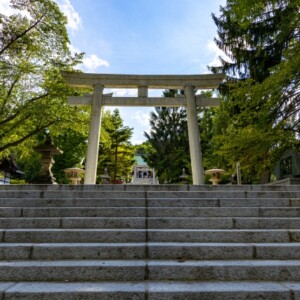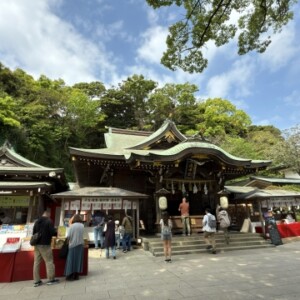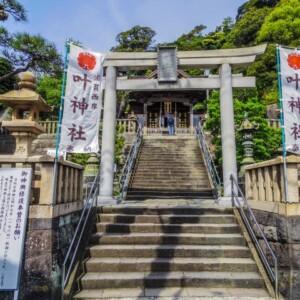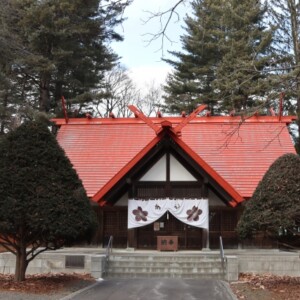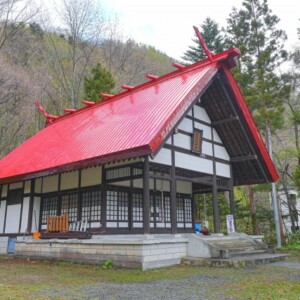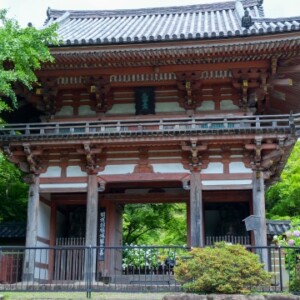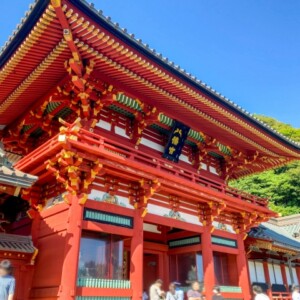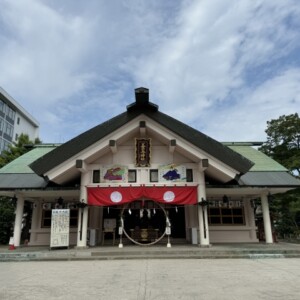
Yukura-jinja Shrine|Complete guide to the history, highlights, and worship information of this historic shrine
Located at the entrance to Hakodate’s Yunokawa hot spring resort, Yugura Shrine is a historic shrine with a history of over 500 years as the birthplace of hot springs. Dedicated to the deities Okonoki-kami and Shohikonoko-kami, the shrine is well known to many people as the god of medicine and hot springs. Known for its unique omikuji (fortune) and unique amulets, the shrine is a popular sightseeing spot in Hakodate.
Outline and Basic Information on Yukura Shrine

Yukura Shrine is located in Yukawa-cho, Hakodate City, Hokkaido, and continues to be loved by the local people as the chief guardian of the Yunokawa hot springs. Located on a small hill overlooking the hot spring resort, the shrine grounds offer beautiful views of Hakodate. Formerly a village shrine, it is now one of the largest shrines in the southern Hokkaido area, with approximately 5,000 households and 30,000 worshippers.
History and Origin
Yugura Shrine dates back to around 1453 (Kyoutoku 2). According to legend, a woodcutter discovered a hot spring on a small hill near the present Yugura Shrine on his way home. Later, when the woodcutter was suffering from joint pain, he was grateful to the hot spring for curing his ailment and built a small shrine called “Yakushido” to enshrine the Yakushi Nyorai (Medicine Buddha).
In the Edo period (1603-1867), Takahiro Matsumae, the fourth lord of the Matsumae domain, became seriously ill and visited Yunokawa for a hot spring cure. He prayed for Takahiro’s recovery from his illness, and the shrine’s status as a shrine was established as a result of the miracle he received. According to the record of a survey conducted by the Matsumae clan in 1717, Yakushi Nyorai was already enshrined at the yuza in 1617, confirming that the shrine had functioned as a place of worship since the early Edo period.
With the separation of Shinto and Buddhist deities during the Meiji period (1868-1912), the shrine changed its name from Yakushi Nyorai to its current deities, Okonoki-kami and Shohikonokami, and took its present form as Yugura Shrine. Over its long history, the shrine has grown along with the development of Yunokawa Onsen and is now one of Hakodate’s representative tourist attractions.
Deities and Benefits
The two deities of Yugura Shrine are Ohonamuchi no Kami and Sunahikona no Kami. Ohonamuchi is another name for Okuninushi, the main deity of Izumo-taisha Shrine, and is widely worshipped as the god of land reclamation, agriculture, commerce, and matchmaking. Shohikonokami is known as the god of medicine and hot springs, and is believed to be beneficial for healing illnesses and promoting health and longevity.
These two deities are said to have cooperated with each other in the Kojiki and Nihonshoki to build the nation, and their achievements, especially in medicine and hot springs, are passed down from generation to generation. The shrine is said to offer a wide range of benefits, including prosperous business, good luck, marriage, easy childbirth, healing of illness, and health and longevity, and attracts visitors from all over Japan as well as local residents.
In particular, the shrine’s blessings as the god of hot springs are unique to Yugura Shrine, the birthplace of Yunokawa Onsen. It is a special place of health and healing for the body and soul for those who seek onsen therapy, beauty, and relaxation.
Highlights and Features of Yukura Shrine

Yugura Shrine attracts many visitors not only for its historical value, but also for the beauty and unique charm of its grounds. From the traditional shrine architecture to the blessings of nature and modern ideas for awarding gifts, a variety of attractions delight visitors.
Architectural and Structural Attractions
The shrine pavilions of Yukura Shrine are built in the Nagare-zukuri style, an ancient Japanese style of shrine architecture, and are impressive for their graceful curves of the roof and massive structure. The shrine pavilions cover an area of 40 tsubo (about 1,860 square meters), and the shrine grounds cover a vast area of 2,500 tsubo (about 2,500 square meters). The main hall, worship hall, shrine office, and other buildings are designed to provide a comfortable environment for worshipers while maintaining the beauty of traditional Japanese architecture.
A vermilion torii gate stands in the precincts of the shrine, and the approach leading beyond it consists of stone steps that lead worshippers into a sacred space. There is a spacious area in front of the hall of worship, which is designed to allow many worshippers to visit the shrine at the same time. In addition, the shrine office offers red seals and accepts various types of prayers, thus continuing the traditional functions of the shrine into the modern age.
Elaborate carvings and decorations are found throughout the building, testifying to the high level of craftsmanship. In particular, the eaves and pillars of the worship hall are carved with mythological designs and auspicious patterns that are a delight to the eye. These decorations are not merely aesthetic elements, but are also valuable cultural heritage that tell the history and beliefs of the shrine.
A 350-year-old onko tree
Of particular note within the shrine grounds is a magnificent onko tree that is over 350 years old. Onko is a yew tree in the Hokkaido dialect, and this ancient tree is carefully protected as a living witness to the long history of Yukura Shrine. The imposing figure of the tree, which stands over 15 meters tall, is deeply impressive to visitors.
It is believed that this onko tree has been watching over the shrine grounds since the shrine was first built, and is revered as a sacred tree by the local people. The tree is beautiful in all four seasons, with fresh green in spring, deep green in summer, red leaves in fall, and snow-covered in winter.
Many worshippers can be seen touching the sacred tree and praying to it, making it an object of worship for long life, good health, and the safety of one’s family. The area around the tree is also considered especially sacred, a precious place where visitors can calm their minds and offer prayers in tranquility. This is one of the unique highlights of Yukura Shrine, where the power of nature and the history of the shrine come together.
Unique Awards and Omikuji
One of the major attractions of Yukura Shrine is its unique gifts and omikuji (fortune) that cannot be found anywhere else. The most famous is the “Hakodate Ikasu Omikuji,” which is part of the “Ezomikuji” series, a joint project of six shrines in Hokkaido. The fortune is contained in a papier-mâché sticker with a motif of squid, a specialty of Hakodate, and is fished out using a bamboo fishing rod, a fun and popular device.
The omikuji is different from most, as it contains not only the fortune, but also the lucky specialties and spots in Hokkaido, written in the Hokkaido dialect. The friendly admonitions in Hokkaido dialect, such as “Shikkake, ganbariya,” are a special memory for tourists. The papier-mâché squid that you pull out can be taken home, and are popular as souvenirs of your trip.
Another unique omikuji is the “Nade-usagi Omikuji. Made of fragrant camphor wood, these cute rabbit-shaped wooden balls are decorated with 20 different patterns, each of which offers a different oracle. The wooden balls can be placed in a separate amulet bag to be carried around as a talisman, and the beautiful ceramic finish is also very attractive.
The “Kozuchi” amulet, named after the shrine’s deity, Okonoki-kami, is particularly popular. The mallet is believed to bring good luck, fulfill wishes, promote health and longevity, and strengthen the body. The newly introduced “Proverb Omamori” is a unique amulet that brings the wisdom of traditional Japanese proverbs into the modern age.
These awards are designed to be familiar to today’s worshippers in many ways while maintaining the traditional shrine’s prestige. They are especially appreciated by the younger generation and tourists as elements that make shrine visits more accessible and enjoyable.
Guide to Worship

Visits to Yugura Shrine are possible throughout the year, and many visitors come to the shrine. While respecting the traditional manners of worship, the shrine strives to provide easy-to-understand information for those visiting the shrine for the first time.
Worship Etiquette and Manners
The manner of worship at Yukura Shrine is the same as at most Shinto shrines. First, bow when passing through the torii gate, and walk down the approach to the shrine avoiding the center of the path. At the hand-watering basin, purify your left hand, then your right, and rinse your mouth to purify yourself before going to the hall of worship.
In front of the hall of worship, you should bow in the manner of “ni-ai ni haitate ichibai. First, bow deeply twice, then clap twice in front of the chest, and finally bow deeply once. At this time, it is important to pray with all your heart, expressing your gratitude to God and your wishes. It is good manners to gently place your money in the offering box rather than throwing it in.
Please keep quiet and do not disturb other worshippers on the temple grounds. Photography is generally allowed, but please refrain from taking pictures inside the main shrine and in sacred areas, and the use of flash is prohibited. It is also recommended to check with the shrine in advance about bringing pets.
To receive a red seal, present your red seal book at the shrine office and apply during the reception hours. Since red seals are important objects that are considered to be the alter ego of the gods, they must be handled with care and stored appropriately.
Annual and Seasonal Events
Various festivals and events are held throughout the year at Yukura Shrine. The most important event is the annual festival held on September 8, a solemn celebration that carries on the shrine’s history and traditions. On this day, a special ritual is held, and many Ujiko and worshippers attend to pray for the development of the shrine and the well-being of the community.
In the New Year, the shrine grounds are crowded with visitors for Hatsumode, and special awards and limited edition red seals are sometimes available during the Hatsumode period. On Setsubun, a bean-throwing ritual is held, attracting many people who wish to ward off bad luck and bring good fortune. During the cherry blossom season in spring, the shrine is crowded with visitors who come to view the cherry blossoms in full bloom.
In summer, seasonal gifts such as kirie (paper cutout) red seals are available, adding to the enjoyment of visiting the shrine. In autumn, the trees on the temple grounds change color, and the autumn leaves of the onko trees are especially beautiful, attracting many photographers. In winter, the snow-covered precincts are fantastically beautiful, and worshipping in the dignified air is a special experience.
Monthly festivals and various prayer services are also held regularly to pray for the safety and prosperity of the community and the fulfillment of visitors’ wishes. The schedule of these events can be found on the shrine’s official website.
Red Seal and Charm Information
Red seals are available throughout the year at Yukura Shrine from 8:30 a.m. to 6:00 p.m. The red seal is marked with the shrine’s seal, the name of the shrine in beautiful calligraphy, and the date of visit, and is valued as a proof of worship. The first fee is a typical amount and is paid in cash.
Special seasonal red seals are also available, and during the summer months, beautifully designed red seals with kirie (paper cutouts) are especially popular. These limited edition red seals may be available in limited quantities, so we recommend that you visit the shrine as early as possible if you wish to receive one. If you have not brought your own red seal book, you may purchase an original red seal book at the shrine.
In addition to the aforementioned ikasu omikuji and nade-usagi omikuji, various other types of amulets are available, including those for traffic safety, academic achievement, matchmaking, safe delivery, and protection against bad luck. The especially popular omikuji (small mallet) amulet is named after the deity Daikimi, and is especially recommended for those wishing for prosperous business, good health, and longevity.
The newly introduced proverb omamori is a unique concept that brings traditional Japanese wisdom into the modern age, and is popular among the younger generation. Omamori are also awarded at the shrine office, where priests and miko (shrine maidens) provide detailed explanations. You must visit the shrine in person, as they do not award amulets by mail.
Access/Use Information

Yukura Shrine is conveniently located in Hakodate and can be accessed by a variety of means of transportation. The following is easy-to-understand access information for tourists, as well as practical information on visiting the shrine.
Transportation Access
Access to Yukura Shrine is very convenient. It is approximately a 10-minute drive from Hakodate Airport and a 15-minute drive from JR Hakodate Station. When using public transportation, the shrine is in an excellent location, about a 1-minute walk from the Yunokawa stop, the last stop on the Hakodate City Tram Yunokawa Line. If taking the streetcar from Hakodate Station, the ride will take approximately 30 minutes.
It is also accessible by local buses, and is approximately a 2-minute walk from the “Yukura-jinja-mae” stop on the Hakodate Bus Lines. Direct buses also run from Hakodate Station and Hakodate Airport, making it easy for tourists to use. Hokkaido Kanko Bus also stops at the Yukura-jinja-mae stop in the same manner.
If using a rental car, cars can be rented at Hakodate Airport or at car rental companies near Hakodate Station. The roads in Hakodate are relatively well maintained, and with the use of a navigation system, you can reach the city without getting lost. In winter, it is recommended to choose a car equipped with studless tires due to the possibility of snow accumulation.
If you choose to take a cab, it is a relatively quick and affordable way to reach Hakodate, either from in front of Hakodate Station or from the airport. It is an efficient means of transportation, especially if you have a lot of luggage or are traveling with several people.
Address: 2-28-1 Yukawa-cho, Hakodate, Hokkaido 042-0932, Japan
Hours of Admission, Fees, Parking Information
Yukura Shrine is open 24 hours a day, but the shrine office is open from 8:30 a.m. to 6:00 p.m. for the awarding of red seals and the purchase of amulets. If you wish to pray, we recommend that you call in advance to make an appointment. There is no charge for visiting the shrine, and anyone is free to visit.
Free parking for visitors is available in the parking lot for approximately 80 cars, which is large enough for a standard-sized car. There is also a separate parking lot for large buses to accommodate group visits. The parking lot is paved and wheelchair accessible.
During special occasions such as New Year’s Day and major festivals, the parking lot may be full due to the large number of visitors. In such cases, we recommend using paid parking in the vicinity or public transportation. There are several pay parking lots in the Yunokawa hot spring resort area, within walking distance to the shrine.
The shrine grounds are barrier-free, and are well maintained to facilitate wheelchair access. However, some parts of the shrine have steps, so if you need assistance, we recommend that you consult with the shrine in advance. Multipurpose restrooms are also available, and the facilities are designed with small children and the elderly in mind.
The area surrounding the shrine has been developed as a hot spring resort town of Yunokawa, where visitors can enjoy bathing and dining at hot spring inns after visiting the shrine. There are also tourist attractions nearby, such as the Hakodate Tropical Botanical Garden and the Yunokawa Hot Spring Footbath, making this an area where visitors can enjoy themselves throughout the day.
Reference sites
Yukura Shrine official website: https://www.yukurajinja.or.jp/
Hokkaido Jinja Agency: https://hokkaidojinjacho.jp/湯倉神社/



